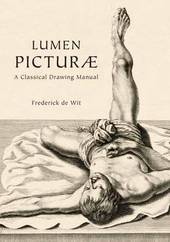
|
Lumen Picturae: A Classical Drawing Manual
Hardback
Main Details
| Title |
Lumen Picturae: A Classical Drawing Manual
|
| Authors and Contributors |
By (author) Frederick de Wit
|
| Physical Properties |
| Format:Hardback | | Pages:172 | | Dimensions(mm): Height 292,Width 203 |
|
| Category/Genre | Drawing and drawings
Art techniques and principles |
|---|
| ISBN/Barcode |
9780062048882
|
| Classifications | Dewey:743.4 |
|---|
| Audience | |
|---|
|
Publishing Details |
| Publisher |
HarperCollins Publishers Inc
|
| Imprint |
Harper Design
|
| Publication Date |
20 July 2011 |
| Publication Country |
United States
|
Description
LumenPicturae is a pictorial guide to classicaldrawing as exemplified by the sublime work of the influential 17th centuryDutch engraver Frederick de Wit. Presenting a carefully curated set of imagesnever before seen outside of rare book archives, Lumen Picturaerenders de Wits' incomparable figure drawings available to the public forthe first time. In the tradition of Harold Speed's The Practice and Scienceof Drawing, Andrew Loomis's Figure Drawing for All It's Worth,Gottfried Bammes' Der NackteMensch, and George Bridgman's Complete Guide to Drawing from Life,the step-by-step visuals in Lumen Picturae arean indispensible handbook for visual artists both professional and amateur, andfor readers of any age or language who want to incorporate the incomparableinsight of classical Dutch figure studies into their drawing today.
Author Biography
Frederick de Wit published his work Lumen Picturae in Amsterdam between 1660 and 1675. It is a book of great historic value that falls within the tradition of the treatises on illustration, which were an essential element in any artist's education up to the impressionist revolution. The complete version of this work, as we present it here, is an excellent introduction to the aesthetic developed in the seventeenth century. It enables us to take up the trail of the education and evolution of a painter in the Dutch Golden Age, characterized by hitherto unknown cultural prosperity and a blossoming of the arts.This work brought de Wit renown and always featured in the publishing house's catalogue. Even today it is fascinating for the great artistic quality of the tables that contributed to the lasting fame of its author, an undisputed master in the arts of printing, engraving, illustration, and painting.
|